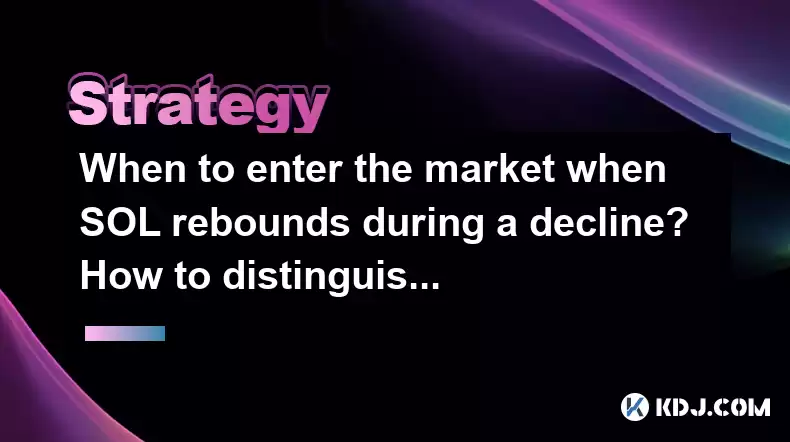-
 bitcoin
bitcoin $108842.957301 USD
-1.88% -
 ethereum
ethereum $3931.777121 USD
-1.66% -
 tether
tether $1.000186 USD
-0.03% -
 bnb
bnb $1153.250882 USD
-2.20% -
 xrp
xrp $2.367904 USD
-1.94% -
 solana
solana $186.182050 USD
-4.20% -
 usd-coin
usd-coin $0.999997 USD
0.00% -
 tron
tron $0.316949 USD
-1.00% -
 dogecoin
dogecoin $0.190780 USD
-3.12% -
 cardano
cardano $0.651324 USD
-2.67% -
 hyperliquid
hyperliquid $37.141055 USD
-0.85% -
 ethena-usde
ethena-usde $0.999224 USD
-0.09% -
 chainlink
chainlink $17.579031 USD
-2.47% -
 bitcoin-cash
bitcoin-cash $509.426284 USD
-2.79% -
 stellar
stellar $0.315298 USD
-2.93%
When to enter the market when SOL rebounds during a decline? How to distinguish between a true rebound and a false breakthrough?
Enter SOL market during rebound with caution; use technical analysis, volume, and sentiment to distinguish true recovery from false breakthrough. Set stop-losses.
Apr 29, 2025 at 10:03 am

When to enter the market when SOL rebounds during a decline? How to distinguish between a true rebound and a false breakthrough?
Understanding the timing of entering the market during a rebound of Solana (SOL) and distinguishing between a true rebound and a false breakthrough is crucial for any cryptocurrency trader. This article will delve into the specifics of identifying these market movements and provide actionable insights on when to make your move.
Identifying a Rebound in SOL
A rebound in the price of SOL can be identified when the asset's price, after a period of decline, starts to increase. This increase can be due to various factors, such as positive news, market sentiment shifts, or technical indicators suggesting a reversal. To pinpoint a potential rebound, traders often rely on a combination of technical analysis and market sentiment.
Technical Analysis: Look for patterns such as the double bottom, where the price hits a low twice before rebounding, or the bullish engulfing pattern, where a small bearish candle is followed by a larger bullish candle. These patterns can indicate that the downward momentum is weakening and a reversal might be imminent.
Volume Analysis: A genuine rebound is often accompanied by an increase in trading volume. If the price of SOL starts to rise on higher volume, it suggests that more traders are buying into the asset, supporting the rebound.
Market Sentiment: Monitor news and social media platforms to gauge the sentiment around SOL. Positive developments or announcements can trigger a rebound, as they increase investor confidence.
Timing Your Entry During a Rebound
Entering the market during a rebound requires careful timing to maximize potential gains and minimize risks. Here are some strategies to consider:
Wait for Confirmation: Instead of jumping in at the first sign of a rebound, wait for confirmation that the trend is indeed reversing. This can be confirmed by a break above a significant resistance level or a moving average crossover.
Use Stop-Loss Orders: To protect against the possibility of a false rebound, set a stop-loss order just below the recent low. This way, if the price falls back, your losses will be limited.
Scale In: Instead of entering the market with your full position at once, consider scaling in. This means buying SOL in smaller increments as the price continues to rise, which can help you average your entry price and reduce risk.
Distinguishing Between a True Rebound and a False Breakthrough
Distinguishing between a true rebound and a false breakthrough is essential to avoid entering the market at the wrong time. Here are key indicators to help you differentiate:
Sustainability of the Move: A true rebound will show sustained upward movement over time, whereas a false breakthrough might see the price quickly revert to its previous level. Monitor the price action over several hours or days to assess the sustainability of the move.
Volume and Liquidity: A true rebound is often accompanied by higher trading volume and liquidity. If the price increase is not supported by significant volume, it might be a false breakthrough.
Technical Indicators: Use indicators like the Relative Strength Index (RSI) and Moving Average Convergence Divergence (MACD) to confirm the strength of the rebound. If these indicators show overbought conditions or divergence from the price action, it might indicate a false breakthrough.
Case Study: Analyzing a SOL Rebound
To illustrate these concepts, let's consider a hypothetical scenario where SOL experiences a decline followed by a potential rebound.
Scenario: SOL has been declining from $100 to $80 over the past week. Suddenly, the price starts to rise, reaching $85 on increased volume.
Analysis:
- Technical Analysis: The price forms a bullish engulfing pattern, suggesting a potential reversal.
- Volume Analysis: The increased volume supports the possibility of a genuine rebound.
- Market Sentiment: A positive news release about a new partnership for SOL coincides with the price increase.
Decision: Based on these factors, a trader might decide to enter the market at $85, setting a stop-loss at $79 (just below the recent low) and scaling in if the price continues to rise.
Practical Steps to Enter the Market During a SOL Rebound
Entering the market during a SOL rebound involves several practical steps. Here's a detailed guide:
Monitor the Market: Keep an eye on SOL's price action, volume, and market sentiment. Use trading platforms like Binance or Coinbase to access real-time data.
Identify the Rebound: Look for the technical patterns and volume increases mentioned earlier. Use charting tools to analyze SOL's price movements.
Set Up Your Trade:
- Choose Your Entry Point: Based on your analysis, decide on an entry point. If you're waiting for confirmation, you might enter once the price breaks above a key resistance level.
- Set a Stop-Loss: Place a stop-loss order just below the recent low to limit potential losses.
- Determine Position Size: Decide how much SOL you want to buy. Consider scaling in if you're unsure about the sustainability of the rebound.
Execute the Trade: Once you've set up your trade, execute it through your chosen trading platform. Monitor the trade closely, especially in the initial stages, to ensure it moves in your favor.
Adjust as Needed: If the price continues to rise, you might consider scaling in further or adjusting your stop-loss to lock in profits.
Frequently Asked Questions
Q1: Can market sentiment alone be a reliable indicator for entering a SOL rebound?A1: While market sentiment can provide valuable insights, it should not be the sole indicator for entering a SOL rebound. Combining sentiment analysis with technical analysis and volume data provides a more comprehensive view of the market's direction.
Q2: How long should I wait to confirm a SOL rebound before entering the market?A2: The duration can vary, but a common approach is to wait for at least a few hours to a day after the initial signs of a rebound. This allows time for confirmation through sustained price movement and increased volume.
Q3: What should I do if the price of SOL falls back after I enter during a rebound?A3: If the price falls back, your stop-loss order should limit your losses. Reassess the market conditions and consider whether the initial rebound was a false breakthrough. If so, it might be wise to exit the position and wait for a more reliable entry point.
Q4: Are there specific times of the day that are better for entering a SOL rebound?A4: Market volatility can vary throughout the day, with higher activity often seen during major market sessions (e.g., New York, London, and Asian sessions). However, the best time to enter a SOL rebound depends more on the specific market conditions and technical indicators than the time of day.
Disclaimer:info@kdj.com
The information provided is not trading advice. kdj.com does not assume any responsibility for any investments made based on the information provided in this article. Cryptocurrencies are highly volatile and it is highly recommended that you invest with caution after thorough research!
If you believe that the content used on this website infringes your copyright, please contact us immediately (info@kdj.com) and we will delete it promptly.
- Crypto Coins with 100x Potential: Is Blazpay Presale the Real Deal?
- 2025-10-17 12:25:13
- Strike Gold in the Digital Age: Exploring Global Gold and the On-Chain Gold Ecosystem
- 2025-10-17 12:25:13
- US Government, Bitcoin Seizure, and the Chen Zhi Scam: A NYC Perspective
- 2025-10-17 12:45:17
- MAS, Tokenised Liabilities, and Stablecoins: A Singaporean Symphony
- 2025-10-17 12:30:08
- Solana, Dogecoin, and the Crypto Dip: Bargain Hunting or Dodging Bullets?
- 2025-10-17 10:45:16
- Gold, Bitcoin, and Investment: Navigating the Digital Frontier in Style
- 2025-10-17 10:25:15
Related knowledge

Practical parameter settings for a Bitcoin multi-timeframe moving average system
Sep 18,2025 at 10:54pm
Optimizing Timeframe Combinations for Bitcoin Trading1. Selecting appropriate timeframes is crucial when building a multi-timeframe moving average sys...

How can I filter out false breakouts in Dogecoin high-frequency trading?
Sep 22,2025 at 01:00am
Understanding False Breakouts in Dogecoin Trading1. A false breakout occurs when Dogecoin's price appears to move beyond a defined support or resistan...

Techniques for identifying tops and bottoms in the Bitcoin on-chain NVT model
Sep 20,2025 at 07:54pm
Understanding the NVT Model in Bitcoin Analysis1. The Network Value to Transactions (NVT) ratio is often described as the 'P/E ratio' of the cryptocur...

What does the surge in open interest in Bitcoincoin futures mean?
Sep 20,2025 at 11:18pm
Understanding the Surge in Dogecoin Futures Open Interest1. A surge in open interest within Dogecoin futures indicates a growing number of active cont...

How can I use the Ethereum USDT premium to gauge market sentiment?
Sep 18,2025 at 11:55pm
Understanding the Ethereum USDT Premium1. The Ethereum USDT premium refers to the price difference between USDT (Tether) traded on Ethereum-based plat...

What should I do if Ethereum staking yields decline?
Sep 20,2025 at 06:18am
Understanding the Causes Behind Declining Ethereum Staking Yields1. The Ethereum network transitioned to a proof-of-stake consensus mechanism with the...

Practical parameter settings for a Bitcoin multi-timeframe moving average system
Sep 18,2025 at 10:54pm
Optimizing Timeframe Combinations for Bitcoin Trading1. Selecting appropriate timeframes is crucial when building a multi-timeframe moving average sys...

How can I filter out false breakouts in Dogecoin high-frequency trading?
Sep 22,2025 at 01:00am
Understanding False Breakouts in Dogecoin Trading1. A false breakout occurs when Dogecoin's price appears to move beyond a defined support or resistan...

Techniques for identifying tops and bottoms in the Bitcoin on-chain NVT model
Sep 20,2025 at 07:54pm
Understanding the NVT Model in Bitcoin Analysis1. The Network Value to Transactions (NVT) ratio is often described as the 'P/E ratio' of the cryptocur...

What does the surge in open interest in Bitcoincoin futures mean?
Sep 20,2025 at 11:18pm
Understanding the Surge in Dogecoin Futures Open Interest1. A surge in open interest within Dogecoin futures indicates a growing number of active cont...

How can I use the Ethereum USDT premium to gauge market sentiment?
Sep 18,2025 at 11:55pm
Understanding the Ethereum USDT Premium1. The Ethereum USDT premium refers to the price difference between USDT (Tether) traded on Ethereum-based plat...

What should I do if Ethereum staking yields decline?
Sep 20,2025 at 06:18am
Understanding the Causes Behind Declining Ethereum Staking Yields1. The Ethereum network transitioned to a proof-of-stake consensus mechanism with the...
See all articles










































































